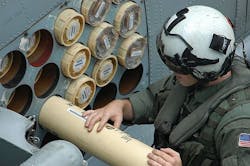Navy reaching out to industry for expertise in bistatic sonobuoys for wide-area airborne ASW
PATUXENT RIVER NAS, Md., 29 Jan. 2015. U.S. Navy anti-submarine warfare (ASW) experts are moving forward with a program to develop wide-area airborne search capability to detect and track enemy submarines using deployed patterns of bistatic sonobuoys.
This capability would deploy fields of sonobuoys that work together in an array consisting of pinging sonar devices, listening devices, and advanced sonar signal processing to detect and track even the quietest and stealthy enemy submarines.
Officials of the U.S. Naval Air Systems Command at Patuxent River Naval Air Station, Md., issued a sources-sought notice this week (N00019-15-R-2325) for the Coherent Source Sonobuoy project to build aircraft-dropped sonobuoys with bistatic capability for the Navy's ASW Multi-static Active Coherent (MAC) program.
Navy officials are looking for companies with the expertise and resources to build coherent source sonobuoys for the MAC program that have Global Positioning System (GPS) navigation; frequency diversity, high cycle, and other performance enhancements to the probability of submarine detection with reduced operator workload; can be prototyped rapidly, and can ramp-up in manufacturing to deliver as many as 15,000 bistatic sonobuoys per year.
The Navy's MAC program is designed to conduct wide-area search, clearance and battle group screening missions to detect, track, and attack enemy submarines.
The MAC system is composed of three airborne subsystems for the P-3 and P-8A maritime patrol aircraft: the AN/SSQ-125 source sonobuoy, the AN/SSQ-101 air deployable active receiver (ADAR) sonobuoy, and the MAC processing software embedded in the P-3C and P-8A aircraft.
The source sonobuoy produces loud coherent sonar pings, while the AN/SSQ-101 ADAR receives returns from the sonar pings and transmits the information to the aircraft for echo location processing.
MAC is being designed to replace the Navy’s legacy Improved Extended Echo Ranging (IEER) system, which employs non-coherent sources to produce loud sounds that reflect off submarine targets. MAC employs new coherent source buoys that enable several pings, optimized waveforms, and various ping durations.
MAC is expected to have fewer effects on marine mammals and the environment than the legacy IEER system, officials say. Its coherent pulses can provide Doppler-speed sensitive and frequency modulated clutter-suppressing capabilities.
Related: Navy Boeing P-8 maritime patrol jet to receive anti-submarine warfare (ASW) system upgrades
Among the companies expected to take an interest in the Coherent Source Sonobuoy project are the Lockheed Martin Corp. Mission Systems & Training segment in Manassas, Va.; Sparton Electronics in De Leon Springs, Fla.; and Ultra Electronics in Columbia City, Ind.
Sparton and Ultra operate sister companies ERAPSCO and Sonobuoy TechSystems as joint ventures that provide the Navy with sonobuoys and transducers.
Companies with the necessary advanced sonobuoy experience and resources should email responses no later than 31 March 2015 to the Navy's John Gyorda at [email protected]. Phone Gyorda at 301-757-9043 for questions or concerns.
More information is online at https://www.fbo.gov/spg/DON/NAVAIR/N00421/N00019-15-R-2325/listing.html.


